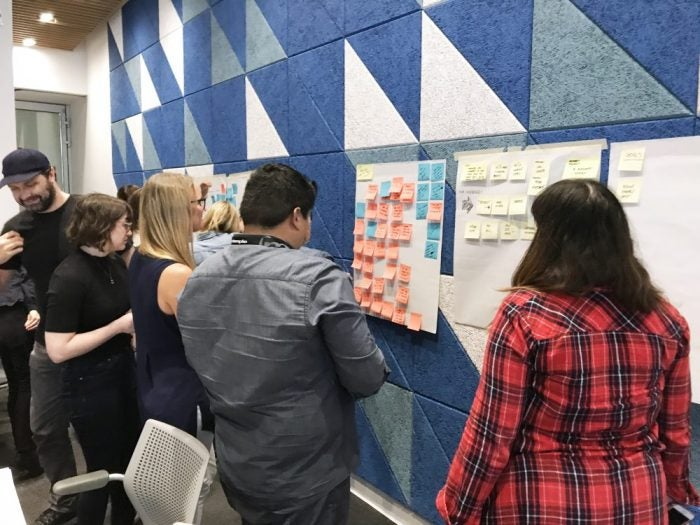Steve Fisher’s Tips for Running a Successful Design and Content Sprint

We’ve all heard the expression “content is king,” and it’s especially true for designers who want to build products and services that effectively provide the user with exactly what they’re looking for, with minimal friction. But design and content teams don’t always work in harmony, and Steve Fisher says that can be disastrous. He’s the founder of The Republic of Quality, a UX and content strategy firm with a secret weapon up its sleeve — design and content sprints that bring designers and content strategists together.

At Adobe MAX, Steve will break down his methodology in his workshop, Running Your Own Design and Content Sprints. We asked him to preview some of the whys and hows that design and content teams can use to come together to make great things happen.
What does a design and content sprint look like?
We know that design sprints are a really useful tool. They definitely speed up communication, ideation and general understanding for any project. I’ve noticed, however, that the players in the sprint don’t often consider how to strategize good content.
Any good designer knows that design is informed by its content, not the other way around. So, with the sprints I’ve been running, the team takes what I call a “content-design” or “content modelling” approach,where the design is informed by the l content we’re going to be working with throughout the project.
How do you start?
At the beginning of a project, we don’t know every piece of content we’ll have, but we should be able to identify who we’re working for (that is, the audience) and what their needs are. Then, if it’s a pre-existing product, we’ll be working with some existing content that may change over time. We take those, break them down, and try to understand the users and their business needs..
From there, we begin to model an interface, a concept, or an idea that can be successfully communicated to meet the user’s needs. So it’s this really rapid ideation process that typically takes between three to five days to complete. Sometimes it’s fewer, but never more.
Who should be part of the content and design sprint?
The roles within the team matter a lot. In an ideal world, you should assemble your sprint team with:
- A user experience lead (perhaps heading up the project)
- A content lead (a writer, strategist, or subject matter expert)
- A tech lead (unless it’s not a tech-related project)
- A decision maker (who makes decisions related to budgets)
- A graphic designer (involve them from the beginning, not just after the fact)

It’s not always possible to have six different people taking on six different roles in every scenario. Sometimes one person has to perform more than one role. But these types of representations Ensuring that every role is represented makes for a healthy interdisciplinary sprint team. Everyone on the team should have an equal voice (obviously, the decision maker, with their budget knowledge, has the final word).
Don’t think of this as a combination of different teams . During sprints, every member works together, equally. The magical part of this is that it’s like interacting with siblings — you may have a disagreement, but you’ll make it to the other side of that disagreement, and then your relationship will be stronger. Communication is easier because you’re spending 3-5 days in a room, putting up sticky notes, and working out every idea. These sprints also foster team bonding, which you can’t accomplish very easily any other way.
How do you make sure your time effectively?
Before we get rolling on anything, we establish a framework that defines how we’re going to come to agreement on things. We’re never aiming for compromise in our decision making, we’re aiming for complete agreement on everything. It’s not some magical rainbows and hugs agreement — it’s saying that we have established the vision and that we know the audiences.
After we’ve identified our users and our vision, we create a set of guiding design principles (like values) based on those users’ needs.
Finally, we set some high-level goals for the project. The goals don’t need to be specifically measurable, they’re general goals — saying,for example, “In this release, we want to improve the customer service response time by 20 percent.
We complete all of these tasks in a cascading sequence. People (the audience) are first, then the project vision based on the audience’s needs), then the design principles that are based on that vision, and then the project goals that are based on all of the above. It can be really tempting to jump to our goals, but we must start with the “why” before we can get to the “how.”
Once that framework is set, everyone involved finds it easier to make decisions that others on the team can all agree on. It eliminates opinion and preferences and allows us to objectively.
And how does the end user benefit from this process?
The team communicates better together. They’re able to make better decisions for the user. They’re focusing on their user base throughout the sprint and, ideally, at the end of the sprint, they bring in some of the users to test the result..
Another approach is to bring in a team member who is part of the user base for part of the sprint to help ideate and answer questions about the audience. That user represents that audience. This doesn’t always work, since one person can’t accurately represent an entire group, but it is useful to have initial feedback before starting the first user testing session.
Why are you so passionate about running design and content sprints in your work?
I run these sprints on every project I do. They always lead to that aha! moment when the team connects and starts to fire on all cylinders. Communication that might have taken weeks using emails or phone calls now happens quickly. Your team needs to develop that copresence to get to where you want to be .
The best outcome is that the team walks away with a concept and a documented idea that they can begin to work on immediately — a point that normally would have taken weeks to get to.
This sprint framework can be seen as an expensive process because of the number of people in the room at one time, but it’s actually far more expensive not to do this — when miscommunication and an overextend project can be the result.
You can learn more about Steve Fisher’s work on his company’s website, and hear more about his approach to design and content sprints during his talk at Adobe MAX.